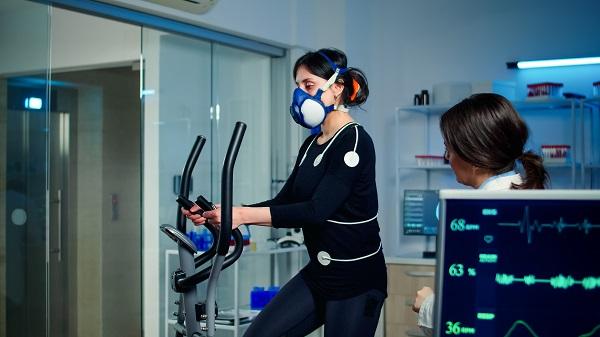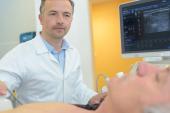Cardiopulmonary Tests in Long COVID Offer Some Clues, Pose More Questions
One expert said the “mixed bag” of studies in this meta-analysis speak to the range of underlying pathologies in need of solutions.

Many patients with symptoms of long COVID have reduced exercise capacity, which if better understood might be helpful in managing their treatment, according to a systematic review and meta-analysis of nearly 40 studies.
The analysis was conducted by researchers studying volunteers as part of the Long-term Impact of Infection with Novel Coronavirus (LIINC) cohort.
“One of the things we were noticing was that participants were reporting reduced exercise capacity, especially those who had other long COVID symptoms,” said Matthew S. Durstenfeld, MD (University of California, San Francisco at Zuckerberg San Francisco General Hospital, CA). “As we were starting to do our own cardiopulmonary exercise test, we wanted to see what other people had done and what they had found.”
In a paper published October 12, 2022, in JAMA Network Open, his group reports that compared with people without long COVID, those with ongoing symptoms had an exercise capacity that was reduced an average of 5 mL/kg/min on cardiopulmonary exercise testing (CPET).
“This finding really does validate that we can objectively measure something in long COVID, at least in comparison to people who don't have long COVID,” Durstenfeld told TCTMD. The researchers believe that studying the trajectory of exercise capacity in these individuals could help with the design of therapies to address various aspects of long COVID.
However, the meta-analysis also uncovered significant heterogeneity among the studies, including in how CPET was administered (treadmill, upright cycle ergometer, or supine cycle ergometer).
Commenting on the meta-analysis, Donna Mancini (Icahn School of Medicine at Mount Sinai, New York, NY), told TCTMD that it “highlights that it's safe to do [CPET] in patients who have long COVID.” Also important, she added, is that the disparate studies of long COVID are pointing toward a complex condition that likely results from several different pathologies.
“I think what we need to do is try to define groups of long COVID patients better and once we do that, we'll be able to target their treatment better,” she said. “Many of them have hyperventilation, which causes metabolic changes such as persistent low levels of carbon dioxide in the bloodstream. So, if you can tease out the patients who have these ventilatory abnormalities, then you can target those patients and have them do breathing retraining and other maneuvers that may help.”
Other patients with long COVID actually have fibrotic changes to their lungs and these would need specific targeted therapies, whereas patients who have cardiac defects as a result of having had COVID would need different treatments again. “Right now we have a bunch of different causes to the syndrome of what we call long COVID,” she observed.
But Mancini, who led one of the studies included in the meta-analysis, pointed out that the new paper doesn’t clarify much, since not all of the studies included were peer reviewed while others included both hospitalized and nonhospitalized patients, had varied definitions of long COVID, and by turns excluded or included patients with abnormal chest X-rays and echocardiograms.
“It’s a mixed bag,” she said. “The variability in the exercise test is definitely a problem in this meta-analysis and doing similar exercise testing would be helpful for future comparisons.”
Durstenfeld added that some of the studies, particularly those that incorporated invasive cardiopulmonary exercise testing involving a pulmonary artery catheter and an arterial line, or cardiac MRI during exercise, are not as effective as true maximal CPET studies.
“It's harder to measure what someone's true exercise capacity is, and you may not be able to measure things like chronotropic incompetence if you stop the test once they get to 85% of their predicted heart rate,” he continued. “I would encourage cardiologists to do a maximal CPET as opposed to a submaximal study, because I think that there's a lot more information that can be gained by that.”
Chronic Fatigue Overlap
For the study, Durstenfeld and colleagues analyzed 38 studies in which CPET was performed between 3 and 18 months after a COVID infection. Of the 2,160 patients, 1,228 had a range of symptoms consistent with long COVID, including persistent dyspnea, fatigue, and muscle weakness. The majority of the included studies were single-center case series of patients attending long COVID clinics or referred for clinical CPET, as well as cross-sectional assessments of posthospitalization patients.
In nine studies that tested CPET in 464 individuals with long COVID symptoms and 359 individuals without, not only was the mean peak oxygen consumption (VO2) on CPET reduced, but also there was evidence of deconditioning and peripheral limitation, dysfunctional breathing, hyperventilation, and chronotropic incompetence—the inability to increase heart rate to match cardiac output while exercising. Durstenfeld and colleagues note that most of the studies in the meta-analysis “recruited before widespread vaccination, but one study reported lower peak VO2 among unvaccinated compared with vaccinated individuals.” The studies also differed by methodology and in how CPET was administered (treadmill, upright cycle ergometer, or supine cycle ergometer).
When the researchers looked for patterns or mechanisms responsible for reduced exercise capacity (defined as less than 80% or less than 85% of predicted levels), deconditioning was considered the most prevalent pattern in 10 studies, although the majority of these patients were hospitalized at the time of the test. Durstenfeld et al say muscular and/or peripheral oxygen extraction abnormalities were also commonly reported in some of the studies.
“Some people seem to think that exercise capacity reductions in long COVID are all due to deconditioning because people are sick and therefore not exercising either when they're acutely ill in the hospital with severe acute COVID, or just from not feeling well and not getting back into exercise after their initial acute illness,” Durstenfeld said. “But I think our study pushes back pretty hard that that just doesn't seem to be all explained by deconditioning, although that certainly is a contributor.”
Another theory that isn’t fully support by the meta-analysis is that ventilatory limitations account for all cases of reduced exercise capacity.
“It doesn't seem like it's persistent lung disease that's really causing this,” Durstenfeld added. “And in terms of the cardiac limitations, there were a couple of studies that found issues with preload failure or inability to augment stroke volume despite normal cardiac function at rest and inability to increase chronotropic incompetence, but cardiovascular limitations also don’t really seem to explain what we’re seeing either.” Instead, the researchers suggest that autonomic dysfunction and endothelial dysfunction are possible sources of reduced exercise capacity, which they say “could be caused by SARS-CoV-2 infection of neurons and endothelial cells, chronic inflammation, or autoimmune mechanisms.”
Long COVID researchers also are looking to chronic fatigue for some answers, since some studies, like the one by Mancini, show that up to 50% of long COVID patients have symptoms consistent with myalgic encephalomyelitis/chronic fatigue. The two syndromes appear to have considerable overlap, Mancini added, with shared symptoms like reduced peak VO2 and chronotropic incompetence.
“But in terms of can we look at chronic fatigue and apply treatments to COVID, the problem is that there's no good treatment for chronic fatigue,” she said.
Both Durstenfeld and Mancini said the National Institutes of Health-funded RECOVER study is expected to provide more answers to some of these questions. The study of adults, pregnant people, and children with long COVID is being conducted at more than 200 centers in the US.
L.A. McKeown is a Senior Medical Journalist for TCTMD, the Section Editor of CV Team Forum, and Senior Medical…
Read Full BioSources
Durstenfeld MS, Sun K, Tahir P, et al. Use of cardiopulmonary exercise testing to evaluate long COVID-19 symptoms in adults: a systematic review and meta-analysis. JAMA Network Open. 2022;5(10):e2236057.
Disclosures
- Durstenfeld and Mancini report no relevant conflicts of interest.





Comments